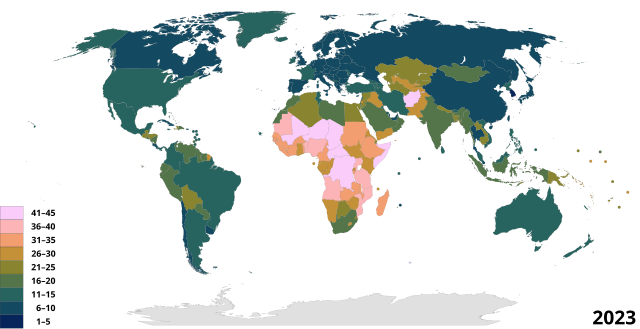Understanding Birth Rate: A Deep Dive into Population Growth and Change

What Is Birth Rate and Why It Matters
The term birth rate may sound simple, but it carries enormous weight in understanding how populations grow, change, and adapt. In its most basic form, birth rate refers to the number of live births per 1,000 people in a given population over a year. It’s a core indicator used by demographers, economists, and policymakers to evaluate a nation’s demographic health. Whether we’re talking about a rapidly growing country like India or a shrinking population like Japan, the birth rate is often one of the first statistics experts examine.
Why is it so important? Because the birth rate directly influences everything from economic growth to social structure. A high birth rate can be a sign of a young and expanding population, which means a larger future workforce but also greater pressure on resources such as food, housing, and education. On the other hand, a low birth rate often points toward an aging society, where fewer young people are entering the workforce to support an increasing number of retirees.
In short, the birth rate is not just a demographic number—it’s a mirror reflecting the state of a society. Understanding it helps governments make informed decisions about healthcare, education, labor markets, and even immigration policies. It’s a key piece of the global puzzle of human development.
Factors Influencing Birth Rates Around the World
The birth rate doesn’t just fluctuate randomly—it’s influenced by a wide range of social, cultural, and economic factors. To begin with, one of the strongest predictors of birth rate is a country’s level of economic development. Generally, developing nations tend to have higher birth rates because of limited access to education and healthcare, particularly reproductive health services. In contrast, wealthier nations often experience lower birth rates due to greater access to contraception and changing lifestyle priorities.
Education, especially female education, plays a crucial role as well. When women have better access to schooling and employment opportunities, they often choose to delay marriage and childbirth. This trend can be observed in many countries where women’s empowerment initiatives have taken hold. For instance, as education levels rise, women tend to have fewer children, prioritizing career growth and financial stability over traditional family structures.
Cultural and religious beliefs also have a significant impact. In some societies, having many children is seen as a blessing or a social expectation, while in others, smaller families are the norm. Additionally, government policies can either encourage or discourage childbirth. For example, some countries offer tax breaks, paid parental leave, and childcare subsidies to boost their birth rates. Others may impose restrictions or campaigns for family planning to control overpopulation. In essence, birth rates are shaped by a complex web of interconnected factors that vary from one region to another.
The Global Decline in Birth Rates
In recent decades, many nations have witnessed a steady decline in birth rates—and this trend is reshaping the global demographic landscape. Developed countries like Japan, Germany, and South Korea are seeing historically low fertility levels, sometimes well below the replacement rate of 2.1 children per woman. This means their populations are not reproducing enough to sustain current levels, leading to a gradual decline in population size over time.
There are several reasons behind this decline. One major factor is urbanization. As more people move to cities, the cost of living increases, and living spaces get smaller. Raising children in urban environments can be financially challenging, leading many couples to delay or forgo parenthood altogether. Another contributing factor is shifting personal values—more individuals are choosing to focus on personal freedom, careers, and lifestyle goals rather than traditional family life.
Additionally, delayed marriages and declining fertility rates are interconnected. Many people are marrying later, if at all, and with later marriages come fewer childbearing years. Combined with rising living expenses, housing costs, and the pressure of modern life, these factors create an environment where having fewer children—or none at all—feels like the more practical choice. The result is a demographic pattern that has long-term implications for economies and societies alike.
Consequences of a Low or High Birth Rate
The consequences of fluctuating birth rates are far-reaching. A low birth rate, while often associated with advanced economies, can lead to serious challenges. For instance, when there are fewer young people entering the workforce, a country’s ability to sustain economic growth can weaken. This is already visible in nations like Japan and Italy, where labor shortages are becoming a real concern. An aging population also increases pressure on healthcare systems and pension funds, as a smaller working population must support a larger elderly demographic.
Conversely, a high birth rate comes with its own set of issues. In countries with limited resources, rapid population growth can strain public infrastructure, education systems, and job markets. When too many people are competing for limited opportunities, poverty levels can rise, and social inequalities deepen. Governments may struggle to provide adequate housing, healthcare, and education, leading to cycles of hardship that are difficult to break.
However, it’s worth noting that neither extreme is ideal. Both high and low birth rates can disrupt economic balance and social stability. The key lies in achieving a sustainable birth rate—one that aligns with a nation’s resources, policies, and long-term goals. For this reason, many governments are now actively trying to manage birth rates through incentives, awareness campaigns, and immigration strategies.
How Governments Respond to Changing Birth Rates
Governments around the world have taken different approaches to address changes in birth rate trends. In countries where the birth rate is declining, such as France and Singapore, policymakers have introduced family-friendly initiatives to encourage childbirth. These include extended maternity and paternity leave, childcare subsidies, and tax incentives for families with multiple children. The idea is simple: make it easier and more affordable for couples to raise children.
In contrast, countries struggling with overpopulation have focused on family planning and awareness. India, for instance, has implemented a wide range of programs over the decades to promote contraception use and educate citizens about the benefits of smaller families. These initiatives have helped stabilize population growth without the need for restrictive or coercive measures.
Interestingly, some governments have also started looking beyond their borders for solutions. For example, nations facing workforce shortages due to low birth rates have turned to immigration to fill the gap. By welcoming skilled workers from abroad, they can maintain economic productivity while adjusting to slower domestic population growth. These diverse strategies show how adaptable policies can be when it comes to managing demographic shifts.
The Future of Birth Rates: What Lies Ahead?
Looking ahead, global birth rate trends suggest a future marked by stark contrasts. Some regions, particularly in Africa and parts of South Asia, will continue to experience high birth rates due to young populations and cultural factors. In contrast, Europe, East Asia, and North America are likely to see further declines unless major policy or social shifts occur.
Technology and societal change will also play a major role. Advances in fertility treatments and healthcare may allow people to have children later in life, slightly offsetting current declines. At the same time, as remote work and flexible job options expand, balancing family and career may become easier, potentially encouraging higher fertility rates in some places.
Yet, the question remains—what kind of balance will humanity strike? Will global populations level out, or will we see even greater divides between growing and shrinking nations? One thing is clear: understanding and managing birth rates will remain one of the defining challenges of the 21st century. The choices countries make today will shape the social, economic, and environmental future of our planet.
Conclusion
The birth rate is far more than a statistic—it’s the heartbeat of a nation’s demographic health. It reflects not just how many children are born, but also how societies value family, work, and the future. From influencing economic policies to shaping cultural norms, birth rates tell the story of humanity’s growth and adaptation over time.
Whether a country faces declining fertility or rapid population expansion, the challenge remains the same: finding balance. Sustainable birth rates ensure that societies can thrive without overburdening their resources or leaving future generations struggling to support aging populations. By understanding the complex web of factors that influence birth rates, we can take thoughtful steps toward building more stable, resilient communities worldwide.



